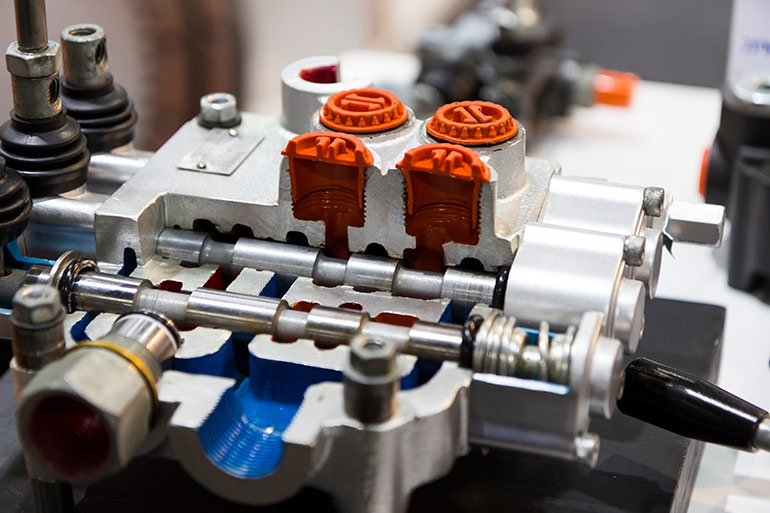By Josh Cosford, Contributing Editor
Let’s be clear that pump selection is the quickest way to increase hydraulic system efficiency, as one can easily improve your energy ROI by 15% or more simply by upgrading from a gear to a piston pump, for example. But pumps aren’t the only way to increase your efficiency, thereby reducing both your factory’s power consumption and carbon footprint.
The most important point to remember in the discussion of hydraulic energy is the respect for thermodynamics. Nearly all input energy lost before achieving useful work is wasted as heat, so your challenge is to honor the end result by selecting a series of efficient components installed intelligently.

Hydraulic control valve
Image courtesy of AdobeStock
Without getting overly technical or delving into expensive, cutting-edge electronic systems, I’ll discuss the many valves best suited for efficient hydraulic operation. Let’s also assume we’re operating within the scope of a load-sensing pump unless otherwise noted since anything less is starting out on the wrong foot.
We often install relief valves close to our pump outlet, and although not necessarily used with load-sensing piston pumps, it’s important for you to know which is the most efficient option available. Pilot-operated designs employ a primary poppet that is actuated by a smaller relief, so it doesn’t have to rely on wasting energy to move the valve itself, such as with a direct-acting version. The act of relieving hydraulic pressure is highly wasteful, which is why a well-designed system places a relief valve for safety purposes only rather than to actively control pressure.
Be very careful when using flow control valves, especially the 3-port priority-flow versions. The best method to control flow is to not create it to start with. This is why load-sensing pressure-compensated pumps are the foundation of efficient hydraulic systems — they produce only the flow demanded from the machine at a marginally higher pressure than required. A 3-port, priority-flow design meters flow through one port while exhausting out another. That exhaust port is often directing fluid from a fixed-flow pump right to tank, wasting energy equal to the combined flow and pressure.
Used frequently in hydraulic circuits are also accessory pressure valves, such as pressure-reducing valves, sequence valves, and counterbalance valves, to name a few. Just as with the relief valve, select only pilot-operated versions when possible. Whenever available, select poppet valves for your application, which are considered to be essentially leak-free. Spool valves are common, but they require increased clearances to operate correctly, leading to inevitable, energy-sapping leakage.
Pressure valves should perform their task while using up as little pressure and flow as possible for the task, so also consider the performance curves of the valve to see that they offer low-pressure drop. Be sure to select the appropriate size and rated flow for your valve — sizing too small will lead to excessive pressure drop, and sizing too large may result in unstable performance.
No hydraulic system is complete without a complement of directional valves, and you’d correctly guess that some are more efficient than others. If you’re auditing every part of the circuit, you’ll do well to switch to poppet directional valves from your spool valves. As with pressure valves, they offer near leak-free operation and are available from small cartridge and stackable valves up to slip-in logic elements capable of thousands of gallons per minute.
Finally, you’ll have guessed correctly that not all directional valves are created equal. For starters, you will often find a discrepancy between the economically friendly brands and the industry standard manufacturers. The high-end brands will use superior raw materials and higher-precision machining combined with bench-tested confirmation of performance. You can expect lower bypass and leakage with the top brands, making the extra investment worthwhile.
The above examples are relatively easy and inexpensive ways to improve the efficiency of your hydraulic machine. Some of these choices are marginally more expensive than their less-efficient counterparts, but the improvement in both performance and efficiency offers a quick return on investment while reducing your carbon footprint as well.
Filed Under: Components Oil Coolers, Engineering Basics, Trending, Valves & Manifolds